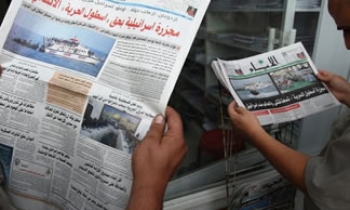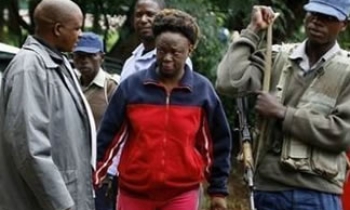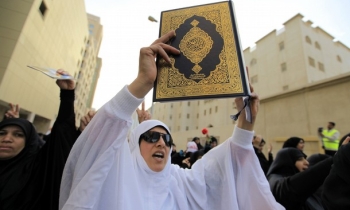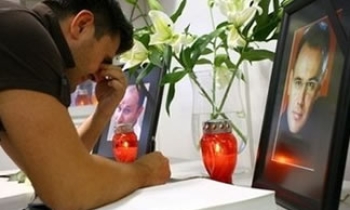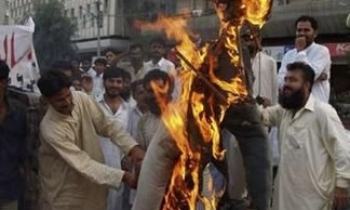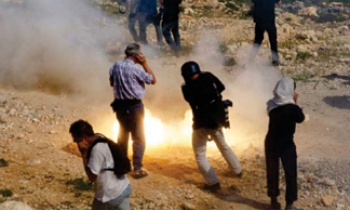Thousands of people flooded the streets of Iran's capital Tehran to mourn the death of the victims of the military aircraft which crashed on Tuesday in the capital, killing 116 people, including 68 journalists, and injuring dozens of others.
The families of the victims have blamed the crash on poor safety procedures. The aircraft was carrying journalists, photographers and cameramen to cover military manoeuvres at Bandar Abbas in the Persian Gulf.

The plane, which allegedly faced technical difficulties before take-off, smashed into a high-rise building in a densely populated residential area in southern Tehran. A few minutes after take-off, the plane radioed for permission to make an emergency landing but failed, and crashed into a 10-storey residential building in Towhid township, near the Mehrabad International Airport.
All 94 passengers and crew on the plane died, the interior ministry said. Several children, at home because schools were closed because of a smog alert in the capital, were among the dead in the building, witnesses said. The Tehran coroner's office told the ISNA students news agency it had received 116 corpses. Twenty-eight people, some in critical condition, were taken to hospitals.
According to Islamic Republic News Agency (IRNA), besides the family members of those who were killed, the gathering in Tehran for the funerals of the victims on Thursday included government officials and members of the armed forces. Majlis Speaker Gholam-Ali Haddad Adel, First Vice-President Parviz Dawoudi and Minister of Culture and Islamic Guidance Mohammad-Hossein Saffar Harandi were among those who joined the processsion.
"We used to see them on TV every day," Hamid, a government employee among the crowds, was quoted by Reuters as saying. "We will miss them very much." Wails and sobs filled the air as mourners walked slowly behind pick-up trucks carrying the coffins of the dead.
The Iran media carried touching tributes to colleagues who died in the crash. "We hear that your burnt press cards have been found, we hear that nothing is left but a few parts of a burnt plane," the semi-official Fars news agency wrote of its photographer and reporter killed in the crash. "But we still do not believe it. We still believe that if you are not here with us it is because you are off for an interview and that you will come back," it said. "You are new-makers today, news which cost you your lives."

Iranian journalists at the scene broke down and consoled one another over their colleagues' deaths, said a Reuters report. "I was supposed to be on the plane as well so I don't know whether to be happy or sad," said a journalist from the ISNA students news agency who declined to be identified. He said a colleague had called him from inside the plane before take off. "He said that the pilot did not want to fly because there was a technical problem with the plane."
Military officials, however, denied media reports that the pilot had complained before the flight that the 30-year-old transport plane was not ready for take-off and that there were problems with the engine. The media in Iran has been critical of officials over the inadequate procedures that are followed. A local newspaper has threatened to publish a transcript of the exchanges between the pilot and the control tower if there are any attempts at a cover-up, said a BBC report.
"Why did they send all those journalists in a plane with technical problems?" asked Mojgan Afshar, the sister of a reporter from the state broadcasting network IRIB who was killed, according to Reuters. She was among hundreds of relatives and colleagues of the victims who went to Tehran's coroner's office to identify their loved ones. Inside a large hall, dozens of blankets were laid out with charred and lacerated body parts. Not one complete body could be seen.
Parivash Nouri, the wife of a photographer from the Hamshahri newspaper, said she had identified her husband by recognising his hands and neck. "His face was totally destroyed," she said. Like many at the office, Nouri said she had received several calls from her husband before take-off telling her that the pilot did not want to fly and that it seemed likely the trip would be cancelled.

Reporters sans Frontières (RSF) expressed its condolences to the families of the victims, and said, "Our thoughts also reach out to the Iranian news media that have been hit very hard by this catastrophe." RSF, in a statement, said, "At the same time, we deplore the fact that journalists on the scene mourning their lost friends were hit by anti-riot police."
General secretary of the International Federation of Journalists (IFJ), Aidan White, said, "Every day journalists and media staff leave the office to carry out their duties, and every day they find themselves taking risks that cannot be avoided. But we expect answers to the questions now being raised about the safety of the airplane in which they were travelling." The IFJ has pledged support from its International Safety Fund to assist the families of the victims in what it said was the worst-ever single loss of life in any accident involving journalists and media staff.
Rodney Pinder, director of the International News Safety Institute (INSI) said, "It was a tragic day for all in the news business. It is an awful reminder of the risks journalists routinely take to cover the news." The disaster – the worst single death toll for journalists on assignment – brings the toll of news media staff who have died covering the news this year to 160. Last year's total of 117 was the worst in 10 years. INSI records all news media deaths on assignment, whether of journalists or support staff and whether deliberate or by accident or from ill health.

